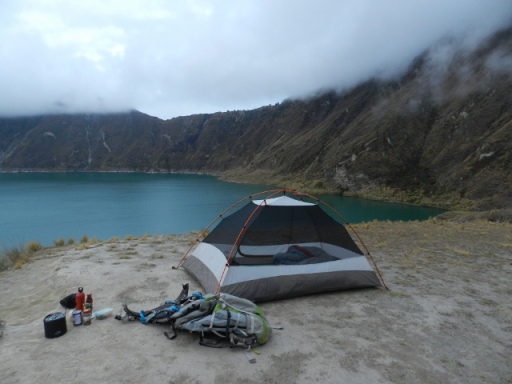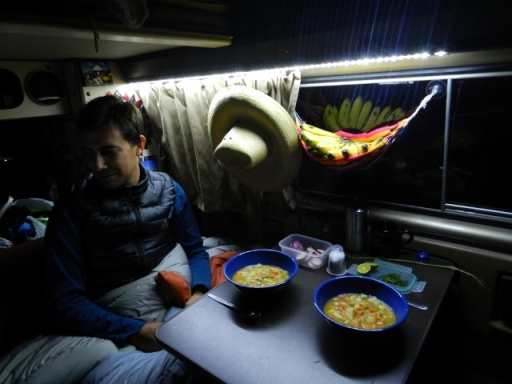For days I had delayed booking spots to snorkel at Leon Dormido (Sleeping Lion) a huge, steep mass of rock jutting out of the ocean a few miles from the shore. Sharks are known to congregate in the channel created by a large crevasse that splits the rock all the way into the ocean. The thought of swimming with sharks was thrilling but also terrifying. Knowing we couldn’t pass up this once in a lifetime opportunity, we nervously made reservations for the next morning.

Leon Dormido (sleeping lion in English), also known as Kicker Rock
After an hour’s ride in a little white fishing boat, we arrived at the magnificent rock. We pulled on our wet suits, donned our snorkel gear, and jumped off the boat into the frigid blue water. As we peered down into the depths we saw the first shark, swimming along the bottom of the ocean far below. I squealed into my snorkel and started pointing excitedly as Aron dove down to take a video. We thought this might be the extent of what we would see since we had heard one needs to scuba dive to really see the sharks since they prefer to swim deep. But when we turned and started to swim through the channel between the two enormous rock faces, we were surrounded by sharks. Schools of large Galapagos sharks smoothly glided through the water right below us as hundreds of black tipped reef sharks swam past us near the surface- I could have reached out and touched one.


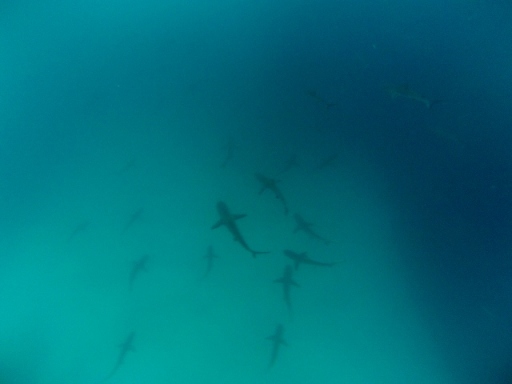
Galapagos Sharks

Black tipped reef shark
The sharks acted as if we weren’t there and tranquilly swam past us in large groups. We watched the beautiful creatures in awe as they swam peacefully in the rays of sunlight that shone through the dark water. A large spotted eagle ray joined the procession, slowly flying through the water. Sea turtles and fish happily swam around but we were nearly too absorbed watching the sharks to bother with anything else.


We had been debating on whether or not to make the expensive leap to the Galapagos Islands when a coolant hose on the van blew while traveling down the coast of Ecuador. Realizing the van would be out of commission for two weeks while we waited for parts to arrive from California, we decided to go for it. And thank goodness we did! Sun, waves, white sand beaches, crystal clear water, and wildlife galore, the Galapagos Islands turned out to be at the top of all the places we’ve visited in our nine months of traveling and we are already plotting ways to go back for more.
As the plane descended we were giddy with excitement when we caught our first glimpse of the islands. It kind of felt like a vacation from our travels. We arrived on San Cristobal Island without much of a plan (as usual), but determined to find a way to experience the Galapagos Islands on the cheap despite what we read in the guidebooks. As we wandered the streets trying to get our bearings while struggling under the load of our heavy packs and Aron’s surfboards, we ran into Steffi, a surfer girl from Germany who invited us to stay at her place for a few nights. Steffi was living in the Galapagos with her Ecuadorian boyfriend who was in Quito at the time handling paperwork for the gorgeous bay front hotel he and his brother are building on the island.
We woke up the next morning to a beautifully blue day which was all I could have wished for on my birthday. Steffi showed us around the island and took us to La Loberia, a beautiful beach popular with sea lions (or lobos, thus the name loberia) and known for its waves and amazing snorkeling. The outer reef that the waves break on also shelters a calm inner bay where sea turtles and sea lions like to frolic. As always, Aron headed straight for the water, excited to get his first taste of waves in nearly two months. Steffi and I sat on the beach, soaked up the hot sun, and fought off Darwin’s famous finches that boldly hopped on and all around us looking for a snack after having been fed too often by tourists.





After we had our fill of sun we suited up and slipped into the cold, clear water and immediately found ourselves swimming with sea turtles. They gracefully swam around, eating green moss off of the rocks not seeming to mind us one bit although in our excitement we were pretty much chasing after them with our cameras.
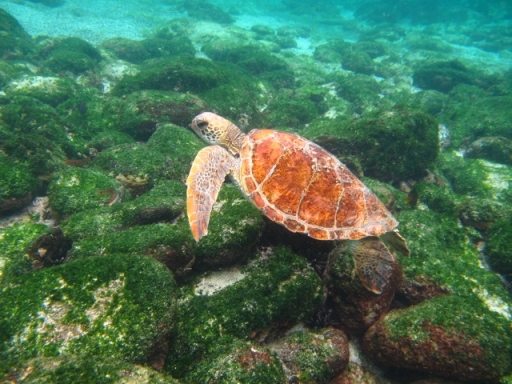


Harassing the sea turtles
As the afternoon clouds rolled in, we took a stroll along a path between dark black volcanic rocks lining the ocean and encountered our first marine iguanas. Aron nearly stepped over the first one without noticing it- they are as dark and rough as the rocks they hang out on and can be difficult to spot until they make a move.
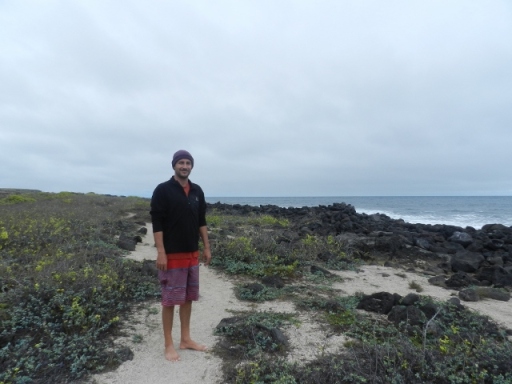



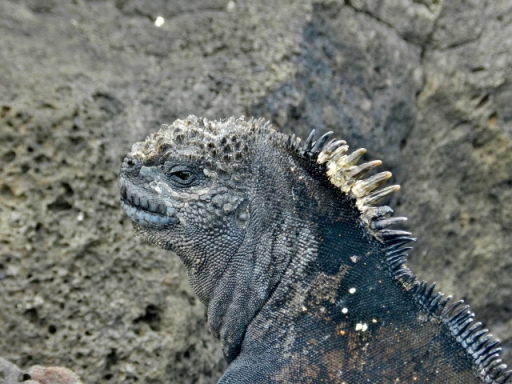
That evening after returning to Steffi’s place sunburned as can be (that equatorial sun is strong!), our lovely host and some of her boyfriend’s family cooked up a delicious birthday dinner featuring brujo (wizard fish) freshly caught off the islands that morning.

The next day we strolled to Las Tijeretas, another epic snorkeling spot. The calm bay is sheltered from wind and waves and you can see straight to the bottom through the clear water. We snorkeled across the bay admiring colorful corals and schools of fish as playful sea lions swam right up and swirled around us.




Photo courtesy of Steffi Herrmann
 While doing some research in mainland Ecuador, we had read that it is possible to camp for free on some of the islands. Both agreeing that camping on the Galapagos Islands would be pretty epic, we decided to lug all of our backpacking gear with us and were determined to put it to use. While on San Cristobal Island, we discovered that in order to camp one has to request permission from the national park and all camping gear must be quarantined in a giant freezer for 48 hours to kill seeds and anything that might disturb or alter the natural environment. After dully going through this process we got clearance and a permission slip from the national park. We loaded our gear in the back of a cab, and headed to Puerto Chino, a beautiful white sand cove on the southern side of the island. We set up our tent on a little grassy knoll at the edge of the beach, right next to a group of sleeping sea lions. From there, we could see turtles swimming near the shore and blue footed boobies dive bombing into the sea in search of fish. It was a spectacular place to camp with no one on the beach but us and the sea lions- well worth the back strain.
While doing some research in mainland Ecuador, we had read that it is possible to camp for free on some of the islands. Both agreeing that camping on the Galapagos Islands would be pretty epic, we decided to lug all of our backpacking gear with us and were determined to put it to use. While on San Cristobal Island, we discovered that in order to camp one has to request permission from the national park and all camping gear must be quarantined in a giant freezer for 48 hours to kill seeds and anything that might disturb or alter the natural environment. After dully going through this process we got clearance and a permission slip from the national park. We loaded our gear in the back of a cab, and headed to Puerto Chino, a beautiful white sand cove on the southern side of the island. We set up our tent on a little grassy knoll at the edge of the beach, right next to a group of sleeping sea lions. From there, we could see turtles swimming near the shore and blue footed boobies dive bombing into the sea in search of fish. It was a spectacular place to camp with no one on the beach but us and the sea lions- well worth the back strain.


This adorable baby sea lion hung out in front of our tent all afternoon

Blue footed boobies


Although cute and graceful in the water, sea lions on land are pretty brutish. They are constantly sneezing, coughing, and barfing up fish, not to mention that they stink terribly. We thought they might deprive us of a peaceful night’s sleep, but each evening at sunset the sea lions woke up from their lazy day of sleeping and farting in the sand and headed into the ocean. We were surprised to notice that they would be out all night and watched them return one by one at sunrise. Very curious…

Classic sea lion pose while his pals dash into the sea for the night
With a swell heading our way, we decided to push back our return flight another week so we could enjoy some more sun and waves and stay on the islands through Aron’s birthday. We posted up at Hotel San Francisco at a whopping $20/night for a clean, private room right on the boardwalk (who says you cant do the Galapagos on the cheap?) and made friends with the surfers in town. Along with two Brits, a Frenchman, and a couple of Ecuadorian locals who owned a bar in town, we trekked daily out to Tongo Reef, an awesome rocky left point break.


The boardwalk in Puerto Baquerizo Moreno on San Cristobal Island

Marine Iguana in the path to Tongo

A rocky entrance/exit at Tongo Reef


It was on one of these beach adventures that we ran into some graduate students from my alma mater, the Bren School of Environmental Science and Management at the University of California Santa Barbara. They were in the Galapagos doing research on the sustainable management of the local lobster fishery for their Master’s Thesis Project. It just so happened that we were on this same island, in the middle of the Pacific Ocean, surfing the same waves at the same time. To say small world would be putting it lightly. After being away for so long I was overjoyed to meet people from back home who were familiar with the world we left behind.

Lounging in the sun with new friends
We spent day after day on the beach under a brilliantly blue sky with Aron surfing fun, peeling waves while I enjoyed the sun and watched turtles pop their heads up out of the crystal clear water. On our last day at Tongo Reef a whale played out on the horizon, breaching out of the water over and over while Aron and our British friend Liam traded waves in the foreground. It’s moments like these (and swimming with sharks) that I hope we remember for the rest of our lives.

Even with the swell pulling back and the waves subsiding, I had to drag Aron away from San Cristobal Island. After a week and a half, we finally hopped on a ferry for the two hour ride to Santa Cruz Island where we had been invited to stay with our new Bren friends for our last four days in the Galapagos. Upon arriving at their house we found Norah in the kitchen, filleting a huge, fresh local tuna. She pleasantly informed us that we were going to be dining at their co-worker’s gorgeous family villa overlooking the bay. Oh la la! Thanks to Norah and Laura’s amazing cooking skills, we enjoyed a fabulous seared rare tuna dinner on the patio overlooking the glimmering lights of Puerto Ayora and the boats on the water. Definitely an unforgettable night with wonderful people and some of the best tuna we have had in our lives!
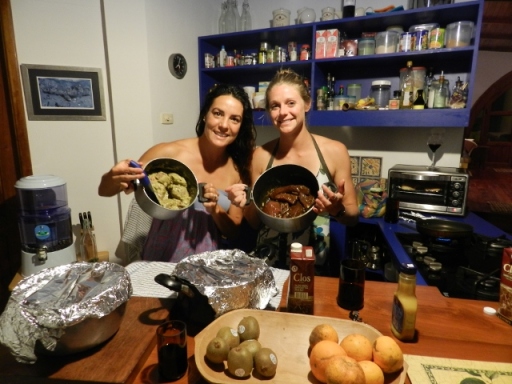
Master chefs Norah and Laura whipping up an amazing dinner
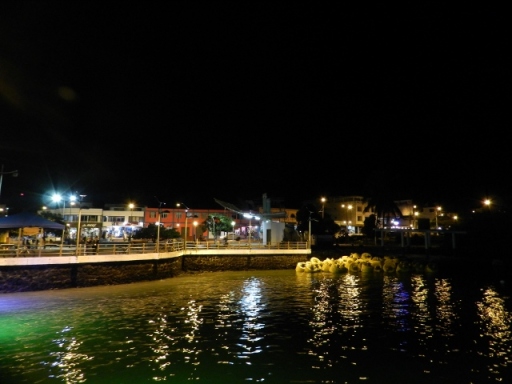
Lights of Puerto Ayora, the main town on Santa Cruz Island
While our hosts were busy at work Aron and I had the day to explore Santa Cruz Island. We rented bikes and took a cab up to the highlands in the center of the island for a little downhill tour. We rode alongside the road with rolling green hills and farms on both sides of us and were surprised to see herds of grazing cows. Definitely not how we imagined the Galapagos islands!
Our first stop was a ranch where giant tortoises roamed freely. We walked right up to them as they happily chowed down in grass in the middle of a field. Too occupied with eating, this guy barely even looked up as I inched in for a picture.

And this guy just blended in perfectly.

Although reluctant to leave the turtles behind, we had to keep moving in order to make it back to the coast before dark. As we rode along the red dirt roads reminiscent of Hawaii, we stopped to let a tortoise slowly cross the road in front of us. Along the way we spotted a number of other giant tortoises hanging out in the shrubbery. Funny to see these huge creatures roam freely in their natural habitat.
Our next stop was the lava tunnels, actual passageways that lava once flowed through when the volcano on the island was still active. Pretty wild to imagine hot magma once flowing where we were walking.

Laura and Aron happen to share the same birthday so on Saturday night we went out for a lobster dinner to celebrate. We splurged on langosta encocado- lobster in a creole coconut sauce- and washed it down with giant cold beers.
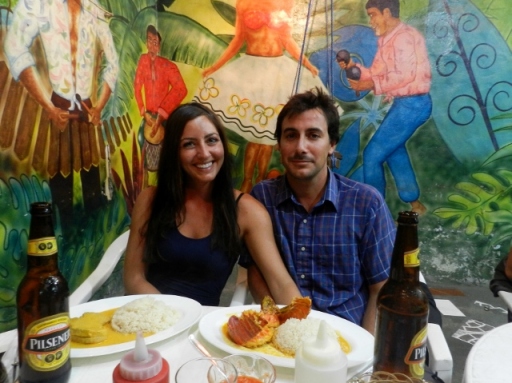
After dinner we surprised the birthday kids with the most deliciously rich, decadent chocolate cake before heading out to the bars.
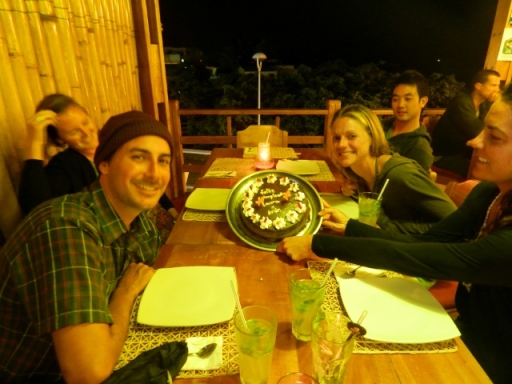
The next morning after a big breakfast, we enjoyed our last day on the Galapagos Islands by hiking out to Tortuga Bay, a gorgeous powdery white sand beach with the most crystal clear turquoise water you can imagine. The sky was as blue as can be and we all played around in the little waves and enjoyed the deliciously cool water.

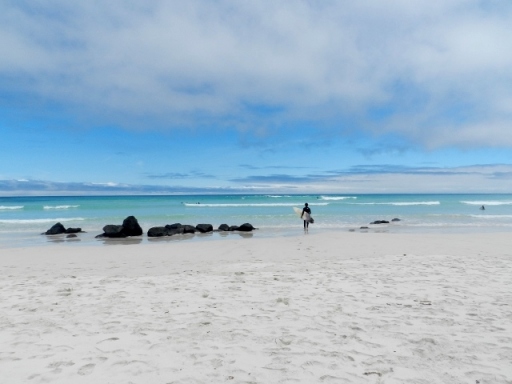

Leaving the Galapagos Islands was harder than we could have ever imagined. When traveling, it’s not just the places that leave their impression on you, it’s the people you encounter and the experiences that you share that really make a place so amazing. We could not have had a better experience on the Galapagos Islands and hope to find our way back someday soon.























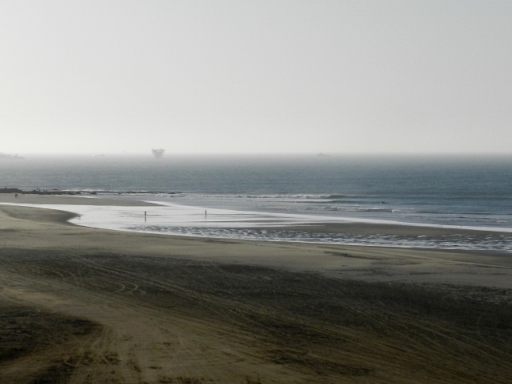






























 While doing some research in mainland Ecuador, we had read that it is possible to camp for free on some of the islands. Both agreeing that camping on the Galapagos Islands would be pretty epic, we decided to lug all of our backpacking gear with us and were determined to put it to use. While on San Cristobal Island, we discovered that in order to camp one has to request permission from the national park and all camping gear must be quarantined in a giant freezer for 48 hours to kill seeds and anything that might disturb or alter the natural environment. After dully going through this process we got clearance and a permission slip from the national park. We loaded our gear in the back of a cab, and headed to Puerto Chino, a beautiful white sand cove on the southern side of the island. We set up our tent on a little grassy knoll at the edge of the beach, right next to a group of sleeping sea lions. From there, we could see turtles swimming near the shore and blue footed boobies dive bombing into the sea in search of fish. It was a spectacular place to camp with no one on the beach but us and the sea lions- well worth the back strain.
While doing some research in mainland Ecuador, we had read that it is possible to camp for free on some of the islands. Both agreeing that camping on the Galapagos Islands would be pretty epic, we decided to lug all of our backpacking gear with us and were determined to put it to use. While on San Cristobal Island, we discovered that in order to camp one has to request permission from the national park and all camping gear must be quarantined in a giant freezer for 48 hours to kill seeds and anything that might disturb or alter the natural environment. After dully going through this process we got clearance and a permission slip from the national park. We loaded our gear in the back of a cab, and headed to Puerto Chino, a beautiful white sand cove on the southern side of the island. We set up our tent on a little grassy knoll at the edge of the beach, right next to a group of sleeping sea lions. From there, we could see turtles swimming near the shore and blue footed boobies dive bombing into the sea in search of fish. It was a spectacular place to camp with no one on the beach but us and the sea lions- well worth the back strain.













































